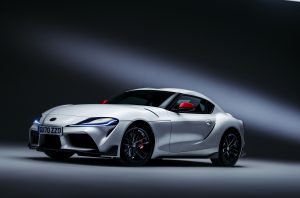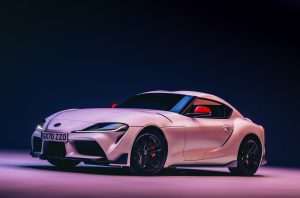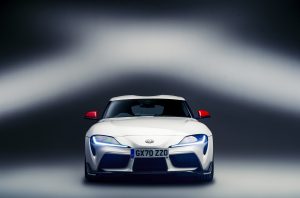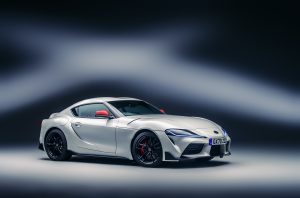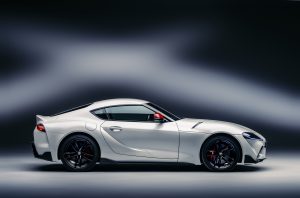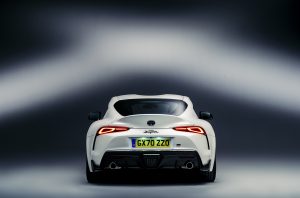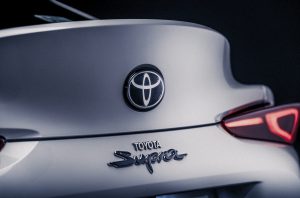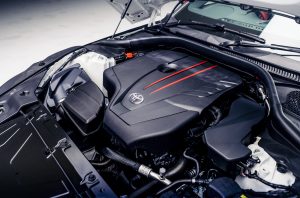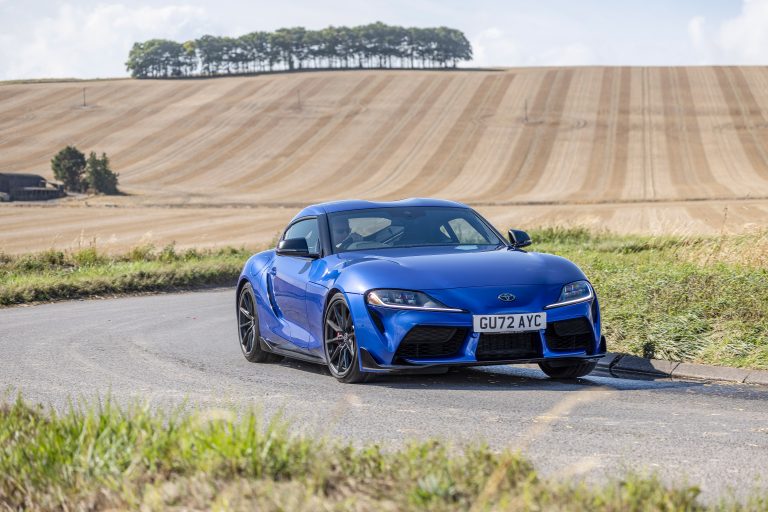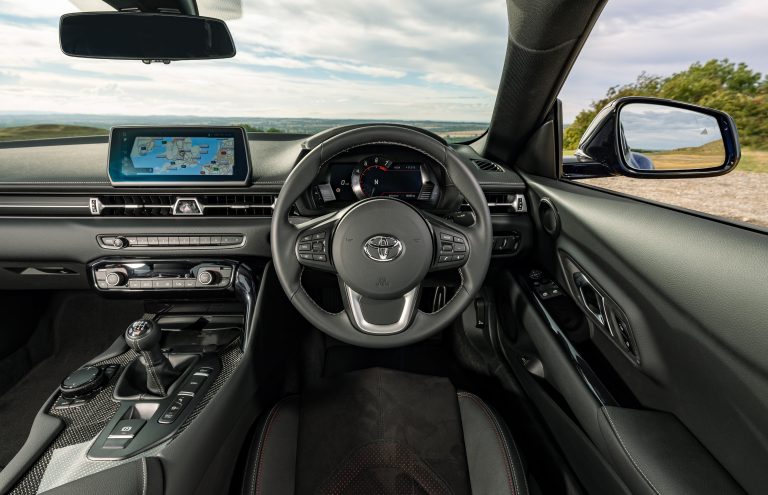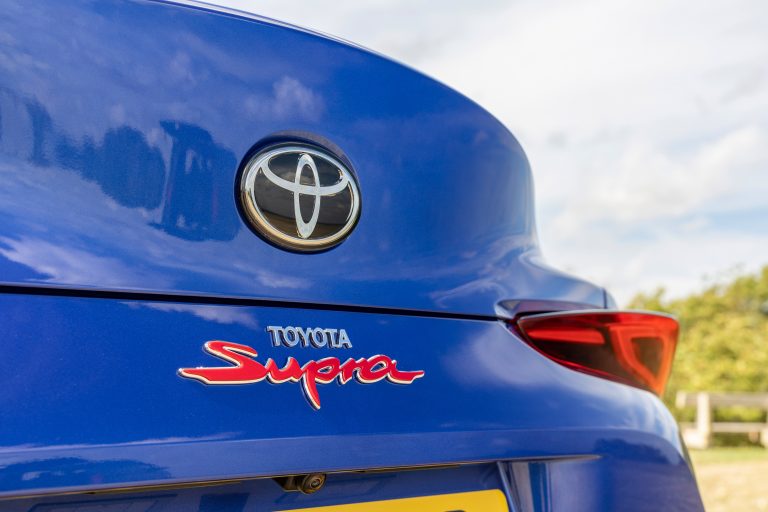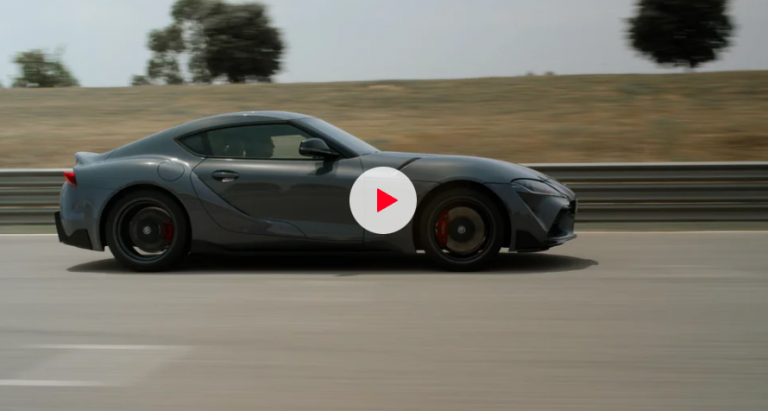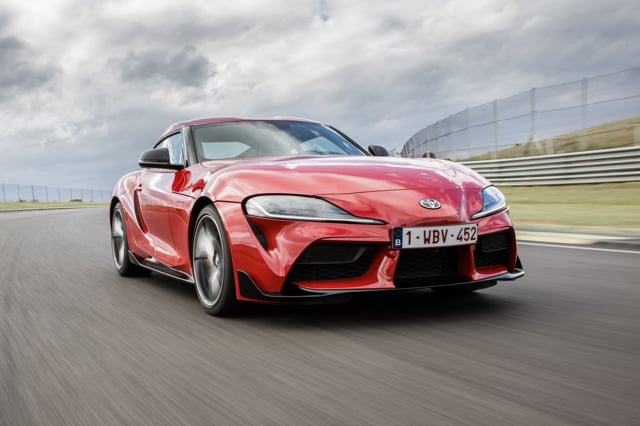The Toyota GR Supra 2.0
- Toyota extends its GR Supra sports car range with new 2.0-litre engine model
- New version retains all GR Supra’s qualities as a sports car in its purest form
- Dynamic benefits gained from using a more compact, lighter power unit – saving of up to 100kg in vehicle kerb weight
- On sale now
INTRODUCTION
The Toyota GR Supra has made a remarkable impact, affirming its status as a sports car in its purest form, designed and engineered for the joy of driving. As the first global model to be developed by Toyota Gazoo Racing, it has drawn on Toyota’s sports car heritage while exploring new horizons of handling and performance.
Now the range is being extended in the UK for the first time with the established 3.0-litre six-cylinder turbocharged engine being joined by a new 2.0-litre four-cylinder turbo unit.
The new 2.0-litre engine widens GR Supra’s market appeal and, being lighter and more compact than the 3.0-litre unit, improves the car’s inertia characteristics and chassis balance for even sharper handling.
Where weight is concerned, the GR Supra 2.0 weighs 100kg less than its 3.0-litre equivalent, a saving that further strengthens the car’s dynamic performance. The engine’s shorter length means its mass is located closer to the centre of the car, supporting an ideal front/rear balance and better inertia characteristics.
Although power is less – 254bhp/190kW – the engine’s performance is rewarding, supported by a muscular 400Nm of torque available across a wide range of engine speeds, harnessed through an eight-speed, rapid-shifting ZF automatic transmission. Nought to 62mph can be accomplished in 5.2 seconds with GR Supra’s launch control system, and top speed matches the 3.0-litre model at an electronically governed 155mph.
UK sales and deliveries of the new GR Supra 2.0 commenced on 4 January 2021, with first deliveries to customers during the same month.
GR Supra: a sports car in its purest form
The Toyota GR Supra has been conceived as a sports car in its purest form, with a front engine/rear-wheel drive configuration, compact, two-seater design and dimensions that achieve the “golden ratio” for optimum handling. Chief Engineer Tetsuya Tada adhered to the classic form of a front-mounted engine driving the rear wheels, building on the heritage of Toyota’s past Supra generations and original 2000GT sports car.
Chief Designer Nobuo Nakamura gave his team a simple brief, so that they were free to express their vision of a pure and individual sports car in a truly original design. The key words he used were “Condensed Extreme”. This refers directly to the vehicle’s packaging, comprising three principal elements: a short wheelbase, large wheels and a wide stance; a taut, two-seat cabin; and a long bonnet with a compact body, reflecting the drivetrain combination of a front engine and rear-wheel drive.
In the finished design, the ‘Condensed’ theme is evident in the relationship between the large-diameter tyres, short wheelbase and overall length. ‘Extreme’ is interpreted in the car’s wide stance, with tight cabin proportions and a broad tread, contributing to a high level of manoeuvrability and stability.
The only external design elements that distinguish the 2.0-litre GR Supra from the 3.0-litre model are the 18-inch wheels and a 90mm diameter bright chrome finisher for the exhaust tailpipe (in place of the 100mm brushed stainless steel finisher on the more powerful model).
In the cabin, the driver’s cockpit neatly combines sports car elements with ultra-modern functionality. Designed to help the driver focus entirely on the business of driving, it is directly influenced by the layout found in single-seater race cars.
The low, slim horizontal dashboard maximises the forward view through the windscreen, helping the driver place the car with precision in high-speed driving, while the principal controls are tightly grouped for quick and easy operation. The instrument panel, centre console and door trim are combined in a seamless design that gives the cockpit a strong, unified feel.
The seats have a racing-influenced design that ensures comfort at all times and excellent support, in particular if the car is being used on-track. Body-holding side bolsters are featured on the cushion and high back, and there is an integrated head restraint.
Driving enthusiasts enjoy an exhilarating blend of power, agility and precision handling, delivered by the car’s combination of a short wheelbase and wide track, light weight, low centre of gravity and highly rigid body. To be certain that the car delivered on its promise, Toyota President Akio Toyoda put it to the test himself at the Nürburgring in his role as a Master Driver before giving it the final green light.
Toyota Gazoo Racing was instrumental in honing the new sports car’s performance, working on the famous Nürburgring Nordschleife and surrounding roads in Germany to achieve the most agile, stable and rewarding handling possible. Further extensive testing was carried out on roads around the world.
PERFORMANCE
- High-performance 2.0-litre engine with twin-scroll turbocharger
- 254bhp/190kW and 400Nm of torque
- Eight-speed ZF automatic transmission with ultra-fast shifting
- Launch control system enables 0-62mph acceleration in 5.2 seconds
- Active differential fitted as standard
2.0-litre turbo engine
The engine deployed in the GR Supra 2.0 is a 1,998cc in-line four-cylinder DOHC 16-valve petrol unit with a twin-scroll turbocharger. It is engineered for agile, powerful acceleration, perfectly suited to the GR Supra’s character as a sports car in its purest form.
Maximum power is 254bhp/190kW at 5,000-6,000rpm, while peak torque of 400Nm is available across an impressive span of revs, from 1,550 to 4,000rpm. This enables 0-62mph acceleration in 5.2 seconds (with launch control function, see below); top speed is electronically limited to 155mph.
A motor-actuated variable valve-timing system provides precise control of the opening and closing of both the inlet and exhaust valves in line with the driving situation to achieve high torque across all engine speeds and high output at high engine revs. In addition, the variable valve lift on the intake side reduces pumping losses, improving the engine’s efficiency.
The direct fuel injection system operates at high pressure – 35MPa – to provide spray atomisation and finely calibrated control to gain high combustion efficiency.
The path from the exhaust to the twin-scroll turbocharger is split into two parts to suppress exhaust gas interference between the cylinders. This allows the turbo to operate from lower engine rpm, giving direct response to the driver’s use of the throttle. Boost pressure is minutely controlled in line with the required torque by means of an electric wastegate valve. This gives excellent boost response for powerful driving performance.
To reduce vibration and enhance smooth, quiet running, the engine is equipped with two balancer shafts.
Sports car performance does not come at a high cost in terms of fuel consumption and emissions: the 2.0-litre turbo achieves 38.7mpg (WLTP combined cycle data) and 167g/km CO2 emissions (WLTP combined).
Transmission
The engine is matched to an eight-speed ZF automatic transmission that provides lightning-fast up and downshifts, with short ratios used for the lower gears. The driver can take control of gear changes using paddle shifts on the steering wheel; they can also select Normal or Sport driving modes to suit their preference and the conditions (details below).
A Launch Control function enables powerful acceleration from standstill with maximum traction, helping the car move from rest to 62mph in 5.2 seconds (this operates when Sport drive mode is selected).
Active Differential
An Active Differential is provided as standard. It operates both when accelerating and decelerating and can seamlessly adjust from zero to full, 100% lock, with instant response.
A dedicated ECU monitors a wide range of inputs, including steering wheel, throttle and brake pressure, engine and wheel speed and yaw rate, for appropriate triggering of the actuator. The torque difference between the left and right wheels is controlled flexibly and seamlessly depending on the driving situation.
This delivers huge benefits in stability and efficiency when the tyres are reaching their performance limit. The effect is felt in all phases of cornering, with increased stability during the braking and cornering phases and then maximum grip as the driver accelerates out of the bend. Operation is adjusted when Sport mode is selected to give more efficient cornering in high-speed driving, for example when using the car on a circuit.
CHASSIS
- Compact and lightweight 2.0-litre engine yields dynamic benefits that give the GR Supra 2.0 its own distinct character
- More compact engine means mass is located closer to the centre of the car, improving inertia characteristics and making ideal 50:50 front/rear weight balance easier to achieve
- Up to 100kg weight saving compared to GR Supra 3.0
Dynamic benefits
The smaller size and reduced weight of the new engine bring specific dynamic benefits to the GR Supra.
Where the 2.0-litre model is concerned, the car tips the scales 100kg lighter than its 3.0-litre counterpart. And because the engine is more compact, its mass is located closer to the centre of the vehicle, making it easier to secure an ideal 50:50 front-rear weight balance and improving its inertia characteristics. This contributes to the car’s responsiveness, agility and confidence-inspiring handling.
“To achieve agile steering and stable cornering, we worked very hard to reduce the new car’s weight, while aiming for a 50:50 weight balance,” said GR Supra Chief Engineer Tetsuya Tada. “This presented us with huge challenges, but we did not want to compromise on our targets.”
Ideal chassis balance
A car’s wheelbase and track dimensions are the first thing to consider when starting the design process with a clean sheet of paper. Where the Toyota GR Supra is concerned, these were defined in order to prioritise the car’s agility and handling.
The key calculation is the ratio between the wheelbase length and the track. It is widely recognised that the best balance of agility and stability is obtained with a ratio of between 1.5 and 1.6; achieving the 1.55 “golden ratio” was thus the starting point for the GR Supra development team, the key building block on which everything else has been optimised. (For reference: wheelbase 2,470mm; rear track 1,589mm).
Suspension
The high body rigidity allowed for more precise and detailed refinements to the suspension geometry and tuning of the shock absorbers. The suspension design comprises double-joint-type MacPherson struts at the front and a five-link system at the rear.
The front suspension subframe and control arm mounting points have been made extremely rigid to yield precise cornering characteristics, while the use of aluminium for the control arms and swivel bearings reduces the car’s unsprung weight, giving superior agility and efficiency. There are also high-performance wheel hubs with an increased camber and optimised kinematics.
The rear suspension benefits from a similarly lightweight design for the rigid subframe and the bracing that connects it to the body, helping ensure extremely precise wheel control. The multi-arm design enables excellent tyre-ground contact to achieve direct steering response and excellent handling and stability.
Adaptive Variable Suspension
The Adaptive Variable Suspension (AVS), fitted as standard, enhances performance with instant response to changes in the road surface, adjusting the shock absorber force at each wheel to maintain a flat vehicle posture, excellent steering response and supple ride comfort. Sensors constantly monitor the way the car is being driven and the road conditions, controlling the damping force accordingly.
The driver can choose between two AVS modes – Normal and Sport – to suit their mood or the driving conditions. Normal mode strikes a high balance between vehicle stability and ride comfort, enabling a sporty drive without sacrificing comfort. Sport mode delivers a flat vehicle posture, reduced body roll and a more agile steering response.
Steering
The electric power steering is rack-assisted and sports tuned. Its characteristics are automatically adjusted in accordance with vehicle speed, reducing the level of effort needed at lower speeds and gradually weighting up to offer greater control and stability at higher speeds. When driving in Sport mode, steering effort is increased, in line with the changes to the chassis and powertrain.
The steering gearbox and motor are mounted separately, which contributes to the car’s low centre of gravity and the optimum positioning of the engine.
The system features a steering rack with the motor and reduction gear mounted separately. This gives greater flexibility for the engine mounting system and also contributes to the lowering of the car’s centre of gravity.
Steering control and responsiveness are supported by a small-diameter, leather-wrapped three-spoke steering wheel with a cross-section shaped to provide the best grip in different driving situations. Contributing to a more engaging drive, paddle shifts are mounted on the steering wheel, and for convenience and minimal driver distraction, there are controls for the audio, hands-free phone operation and cruise control.
Wheels and Tyres
The GR Supra 2.0 is fitted as standard with 18-inch five-double-spoke alloy wheels with a bi-tone black/bright machined finish. To optimise the balance of front and rear grip, larger wheels and tyres are used at the rear. The specific Michelin Pilot Sport tyres are 255/40 ZR18 front and 275/40 ZR18 rear. The limited-run Fuji Speedway Edition version has 19-inch forged alloy wheels with a matt black finish, shod with 255/35R19 96Y tyres at the front and 275/35R19 100Y at the back.
Braking systems
The sport braking package for the GR Supra 2.0 is a lightweight, aluminium system that provides stable stopping performance and excellent controllability. It equips the car with red aluminium Brembo callipers emblazoned with the Supra logo – opposed four-piston units at the front and floating single-piston at the rear. The ventilated discs measure 348 x 36mm at the front and 345 x 24mm at the rear.
The brakes are equipped with standby, drying and anti-fade functions: the drying function applies the brakes at pre-determined intervals when the car’s windscreen wipers are operating to dry the discs; fade prevention automatically increases brake pressure when the discs become hot.
ABS, Brake Assist, Vehicle Stability Control, Traction Control, and Hill-start Assist Control are also featured as standard, together with Active Cornering Assist, which creates additional yaw movements by independent braking intervention to improve agility and line-tracing.
An electronic parking brake is fitted as standard.
Selectable drive modes
The driver can choose between two drive modes – Normal and Sport – to adjust the car’s response and performance to suit the conditions or personal preference.
Selecting Sport mode sharpens throttle response, increases the exhaust note and adds weight to the steering. Transmission shifts are adjusted so that high revs are held for slightly longer and the Adaptive Variable Suspension damping force is increased. The limited-slip differential also adapts for more efficient cornering, to suit circuit driving, for example.
In addition, there is a Traction mode for the Vehicle Stability Control. This allows for a degree of tyre slip, even when the VSC is active.
Interview: Herwig Daenens, Toyota Master Driver
Herwig Daenens was the Toyota Master Driver for the development of the GR Supra, both the 3.0 and 2.0-litre models. These were developed side-by-side in an extensive programme that took place on circuits and a wide variety of different roads around the world. Here he gives a first-hand insight to the detailed work carried out to ensure the Supra 2.0 achieved its handling performance goals.
What were the targets for the GR Supra 2.0 in terms of the driving experience?
They were similar to those for the 3.0 model, in that we set ourselves the target of matching the dynamic performance of one its key competitors.
What are the principal differences when it comes to handling, agility and responsiveness, compared to the 3.0-litre model?
It is not a question of one version being better than the other – they are both great cars in their own way. With the 3.0-litre you have tremendous power and silky-smooth performance of the six-cylinder engine, while the lighter, 2.0-litre combines a decent level of engine performance with even sharper handling DNA.
How significant were the size, weight and location of the engine in defining the Supra 2.0’s performance?
The location of the engine is part of the vehicle’s basic architecture. With Supra we have made a huge engineering effort to push the powertrain as far back in the car and position it as low as possible. Of course, engine size is an important factor, and actually determines its location. And, as in any sports car, you want to keep the weight of the engine, and indeed all components, as low as possible. Because of the shorter length of the 2.0-litre unit, we had the opportunity to move the engine mass even closer to the centre of the car.
Have other chassis modifications been necessary to achieve the desired ride and handling?
Yes, of course we had to modify the chassis set-up for the four-cylinder engine. With less mass, you have to correct the spring rates and adjust the load heights to achieve the desired ride height and natural frequency – the eigen frequency. As a result, the dampers had to be re-tuned as well. The Adaptive Variable Suspension, the limited-slip differential and the electric power steering also required specific tuning of their operating parameters.
The architectural characteristics of the car gave us a decent base to work on, but nevertheless we spent a lot of time fine-tuning as we set ourselves high targets for the car.
How long was the testing process and where did it take place?
The total testing for GR Supra from early mechanical prototype to production version was spread over five years. During that time we took Supra all over Europe and made frequent visits to the USA and Japan as well. As it is sports car, we spent quite some time on tracks – including the Nordschleife at the Nürburgring – but we also tuned our set-up on public roads. Both versions were developed simultaneously from the second development stage. The earliest prototypes (for the first development stage) were all equipped with the 3.0-litre engine. The major learnings we gained from those were carried over to the 2.0-litre.
Were there any surprises during that process?
During the final sign-off drives of the pre-production models, we found that after extended circuit driving in dry conditions, the right-hand front wing and door were always dirty with sand and dust. After investigation, we traced this to a design issue with the filler cap on the washer fluid tank (common to both 3.0 and 2.0 models), which led to fluid being spilled under extreme lateral acceleration. This hadn’t been noticeable when using camouflaged cars. Even though the design had been fixed for a long time, a change was still made to address the issue.
What will be the key rewards in terms of driving experience for customers who chose the GR Supra 2.0?
I can assure them they will be pleasantly surprised by the performance of the “little brother” in all aspects.
EQUIPMENT AND OPTION PACKS
- GR Supra Pro specification includes 18-inch alloy wheels, 8.8-inch multimedia display and Alcantara seat upholstery
- Special Fuji Speedway limited edition model available at launch – production for UK limited to 45 examples
At launch, the new 2.0-litre GR Supra is offered in a high Pro specification, with standard features including 18-inch alloy wheels, a four-speaker 100W audio system with 8.8-inch touchscreen display and heated sports seats upholstered in black Alcantara.
Toyota Supra Safety+ is also be provided, equipping the car with a Pre-Collision Safety system with Braking Function, Pedestrian and Cyclist detection with Braking Function, Lane Departure Alert with Active Steering, Road Sign Assist and Automatic High Beam.
Handling and performance features include Adaptive Variable Suspension, an Active Differential and sport braking system. More detailed information on these features is given in the Performance and Chassis and Handling chapters above.
Multimedia system
The multimedia system for the GR Supra 2.0 is controlled via a centrally mounted 8.8-inch high-resolution TFT touchscreen display. This can also be operated using a controller on the centre console which has an intuitive touchpad control on its upper surface. It is designed for fingertip control so the driver doesn’t have to change their position at the wheel to operate it.
The package includes a four-speaker audio system with DAB radio reception, Bluetooth, a USB port and wireless smartphone integration using Apple CarPlay. The system also provides voice recognition and access to connected online services to help with journey information such as traffic and weather conditions, parking and fuel availability.
Fuji Speedway Edition
At launch the new 2.0-litre GR Supra is offered in an exclusive, limited edition Fuji Speedway Edition. This stands out with a unique white metallic paint finish for the bodywork with contrasting 19-inch matt back alloy wheels and red door mirror housings. In the cabin there are carbon fibre dashboard trim inserts and striking red leather and black Alcantara upholstery. The colour choices evoke those of the official Toyota Gazoo Racing livery.
Where equipment specifications are concerned, the Fuji Speedway also comes with all the features of the Pro model (detailed above).
This special edition model has been created specifically for the launch of the 2.0-litre model, with availability limited to just 45 examples in the UK.
Prices and introductory offer
On-the-road prices for the new GR Supra 2.0 are £45,995 for the 2.0 Pro and £47,395 for the Fuji Speedway Edition.
TOYOTA GR SUPRA 2.0 TECHNICAL SPECIFICATIONS
| ENGINE | |
| Type | 4-cylinder in-line with twin-scroll turbo |
| Fuel system | Direct injection |
| Valve mechanism | DOHC 16-valve with variable lift control (intake) and variable camshaft timing (intake and exhaust) |
| Displacement (cc) | 1,998 |
| Bore x stroke (mm) | 82 x 94.6 |
| Compression ratio | 10.2:1 |
| Max. power (bhp/DIN hp/kW @ rpm) | 254/258/190 @ 5.000-6,500 |
| Max. torque (Nm @ rpm) | 400 @ 1,550-4,400 |
| Emissions level | Euro 6D temp |
| TRANSMISSION | |
| Type | 8-speed Sports Automatic 8HP 51 |
| Gear ratios | |
| 1st | 5.250 |
| 2nd | 3.360 |
| 3rd | 2.172 |
| 4th | 1.720 |
| 5th | 1.316 |
| 6th | 1.000 |
| 7th | 0.822 |
| 8th | 0.640 |
| Reverse | 3.712 |
| Final drive | 3.154 |
| PERFORMANCE | |
| Power-to-weight ratio (kg:kW) | 7.7:1 |
| Max. speed (mph) | 155 (electronically limited) |
| 0-62mph acceleration (sec) | 5.2 |
| FUEL CONSUMPTION (WLTP) | |
| Combined cycle (mpg) | 38.7 |
| Fuel tank capacity (l) | 52 |
| EMISSIONS (WLTP), INSURANCE & WARRANTY | |
| CO2 emissions – combined cycle (g/km) | 167 |
| Insurance groups | 2.0 Pro 34E
2.0 Fuji Speedway Edition 35E |
| New vehicle warranty | 5 years/100,000 miles |
| SUSPENSION | |
| Front | MacPherson strut |
| Rear | Five-link axle |
| STEERING | |
| Type | Rack and pinion, electric power steering |
| Steering ratio | 15.1:1 |
| Min. turning radius – tyre (m) | 5.2 |
| Min. turning radius – body (m) | 5.5 |
| BRAKES | |
| Front | Ventilated discs, 4-pot fixed callipers |
| Rear | Ventilated discs, single-pot floating calliper |
| Front diameter x thickness (mm) | 348 x 36 |
| Rear diameter x thickness (mm) | 345 x 24 |
| TYRES | |
| Type | Michelin Pilot Super Sport |
| Front | 255/40ZR18 95Y
255/35ZR19 96Y |
| Rear | 275/40ZR18 99Y
275/35ZR19 100Y |
| EXTERIOR DIMENSIONS | |
| Overall length (mm) | 4,379 |
| Overall width (mm) | 1,854 |
| Overall height (mm) | 1,292 |
| Wheelbase (mm) | 2,470 |
| Front tread (mm) | 1,594 |
| Rear tread (mm) | 1,589 |
| Load capacity (VDA l) | 290 |
| WEIGHTS | |
| Kerb weight – without driver (kg) | 1,395 |
| Kerb weight – ECE (kg) | 1,470 |
| Gross vehicle weight (kg) | 1,710 |
TOYOTA GR SUPRA 2.0 EQUIPMENT SPECIFICATIONS
| SAFETY & HANDLING | GR SUPRA 2.0 PRO | GR SUPRA 2.0 FUJI SPEEDWAY EDITION |
| Toyota Supra Safety+: Pre-Collision System with pedestrian and cyclist detection, Lane Departure Alert with steering control, Automatic High Beam, Road Sign Assist | ✔ | ✔ |
| Airbags (7) | ✔ | ✔ |
| Child seat restraint system | ✔ | ✔ |
| ABS | ✔ | ✔ |
| Traction Control | ✔ | ✔ |
| Vehicle Stability Control | ✔ | ✔ |
| Seatbelt fastening reminder | ✔ | ✔ |
| Tyre Pressure Monitoring System | ✔ | ✔ |
| Emergency brake light signal | ✔ | ✔ |
| Automatic headlight levelling | ✔ | ✔ |
| Speed-detecting automatic door locking | ✔ | ✔ |
| eCall | ✔ | ✔ |
| Active sports differential | ✔ | ✔ |
| Adaptive Variable Suspension | ✔ | ✔ |
| Sport braking system | ✔ | ✔ |
| Start hold control | ✔ | ✔ |
| Cruise control | ✔ | ✔ |
| COMFORT & CONVENIENCE | GR SUPRA 2.0 PRO | GR SUPRA 2.0 FUJI SPEEDWAY EDITION |
| Automatic dual-zone air conditioning | ✔ | ✔ |
| Tilt and telescopic steering wheel adjustment | ✔ | ✔ |
| Smart entry and push-button start | ✔ | ✔ |
| Automatic wipers | ✔ | ✔ |
| Automatic headlights | ✔ | ✔ |
| Auto-dimming rear-view mirror | ✔ | ✔ |
| Reversing camera with guidelines | ✔ | ✔ |
| Electronic parking brake | ✔ | ✔ |
| 12V power outlet in front cabin | ✔ | ✔ |
| Multimedia/audio/phone/cruise control switches on steering wheel | ✔ | ✔ |
| Remote boot door release in cabin | ✔ | ✔ |
| Front cup holders (x2) | ✔ | ✔ |
| Boot light | ✔ | ✔ |
| Tonneau cover | ✔ | ✔ |
| INSTRUMENTS & CONTROLS | GR SUPRA 2.0 PRO | GR SUPRA 2.0 FUJI SPEEDWAY EDITION |
| Drive Mode Selector | ✔ | ✔ |
| Paddle shifts on steering wheel | ✔ | ✔ |
| Reversing camera | ✔ | ✔ |
| Adjustable speed limiter | ✔ | ✔ |
| Digital speedometer | ✔ | ✔ |
| Gear Shift Indicator | ✔ | ✔ |
| SECURITY | GR SUPRA 2.0 PRO | GR SUPRA 2.0 FUJI SPEEDWAY EDITION |
| Alarm with tilt and intrusion sensors | ✔ | ✔ |
| Locking wheelnuts | ✔ | ✔ |
| Power/remote door locking | ✔ | ✔ |
| Immobiliser | ✔ | ✔ |
| SEATING, UPHOLSTERY & TRIM | GR SUPRA 2.0 PRO | GR SUPRA 2.0 FUJI SPEEDWAY EDITION |
| Height-adjustable seats | ✔ | ✔ |
| Power-adjustable lumbar support | ✔ | ✔ |
| Sports seats | ✔ | ✔ |
| Heated seats | ✔ | ✔ |
| Black Alcantara seat upholstery | ✔ | ✗ |
| Black Alcantara & red leather seat upholstery | ✗ | ✔ |
| Seatback pockets | ✔ | ✔ |
| Aluminium scuff plates | ✔ | ✔ |
| Aluminium sport pedals | ✔ | ✔ |
| AUDIO, MULTIMEDIA & CONNECTIVITY | GR SUPRA 2.0 PRO | GR SUPRA 2.0 FUJI SPEEDWAY EDITION |
| 4-speaker audio system | ✔ | ✔ |
| DAB reception | ✔ | ✔ |
| Bluetooth | ✔ | ✔ |
| USB port | ✔ | ✔ |
| 8.8-inch touchscreen display | ✔ | ✔ |
| Voice recognition | ✔ | ✔ |
| Toyota Supra Connect connected services | ✔ | ✔ |
| EXTERIOR | GR SUPRA 2.0 PRO | GR SUPRA 2.0 FUJI SPEEDWAY EDITION |
| LED headlights with follow-me-home function | ✔ | ✔ |
| Automatic headlight cut-off | ✔ | ✔ |
| LED daytime running lights | ✔ | ✔ |
| LED front light guides | ✔ | ✔ |
| LED rear fog light | ✔ | ✔ |
| LED turn indicators | ✔ | ✔ |
| Cornering lights | ✔ | ✔ |
| Power-adjustable heated door mirrors with auto-retracting and auto-dimming functions | ✔ | ✔ |
| Reverse-tilt function on passenger door mirror | ✔ | ✔ |
| Piano black door mirror housings | ✔ | ✗ |
| Red door mirror housings | ✗ | ✔ |
| 18in black/silver bi-tone 5-double-spoke alloy wheels | ✔ | ✗ |
| 19in matt black 5-double-spoke forged alloy wheels | ✗ | ✔ |
| Tyre repair kit | ✔ | ✔ |
| Red brake calipers with Supra logo | ✔ | ✔ |
| Dual exhaust tailpipes with chrome finishers | ✔ | ✔ |
| Radio antenna integrated in rear window glass | ✔ | ✔ |
| White metallic paint finish | ✗ | ✔ |
ENDS

